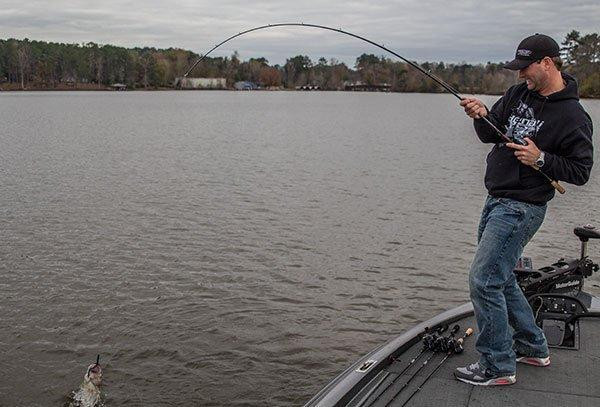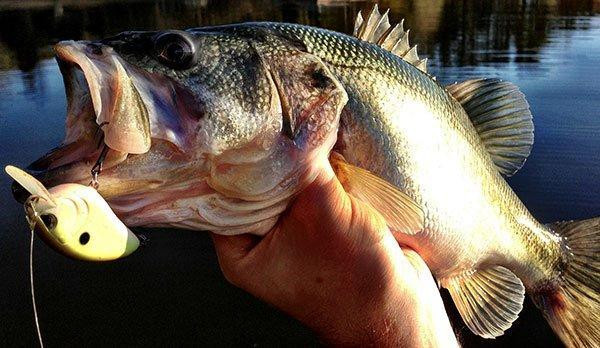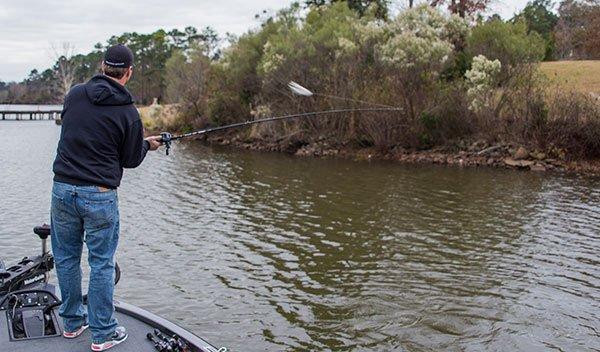When the winter months arrive and engulf your favorite fishery with frigid air, don’t overlook the effectiveness of shallow bass fishing. For years we’ve been told to seek deep, wintertime hangouts in order to catch coldwater bass but going against the grain can result in some unforgettable fishing days.
I’ve been doing a lot of bass fishing lately with my buddy and FLW Tour pro Clayton Batts and to put it plainly—we’ve been whacking ‘em. You won’t find any spinning rods, tiny worms or 8-pound test on my front deck, either. Power fishing has been the predominate pattern and it’s been an absolute blast.
Over the past several weeks, we’ve put together 7 tips to help you get more out of your shallow wintertime fishing.
1. Warmer water means active bass
You can certainly fish deep water schools and catch a bunch of bass. Wintertime bass schools don’t relocate very often, so it’s a great way to catch numbers of fish. If you’re looking to catch bigger bass and have a great chance at a huge limit, however, finding the warmest water is essential.
Did you know? Wind can significantly lower the water temperature in an area, so if it’s super-cold and you’re looking for a shallow bite, calmer areas can actually be more productive.
“When the water gets cold, bass don’t eat very much,” Batts said. “Their metabolism becomes ridiculously slow, resulting in very little feeding activity and small feeding windows. Shallow water warms up faster in sunny conditions, which is the reason I love to fish shallow in cold weather.”
As the sun becomes higher throughout the day, bass will gravitate toward the warmest water available and slowly move onto shallow flats and cover in order to feed. This sparks an increase in their metabolism and makes them more apt to chase down prey.
“Warm water doesn’t only attract bass,” Batts said. “It also attracts big schools of shad and makes the crawfish more active as well. When the bass slide higher into the water column and into shallower water, they have a virtual buffet just sitting there and waiting on them.”
It’s important to note, however, that bass behavior is unique to each specific fishery. On dream fisheries such as Lake Falcon, Lake Fork or Lake Guntersville, it may be totally possible to catch a 30-pound limit in 30 feet of water throughout the winter. On most “normal” fisheries—lakes that most of us likely fish—you can sift through hundreds, and sometimes even thousands, of small, deep water bass before catching a single 3-pounder. If you’re looking for that ever-elusive trophy bass, however, locating the warmest water temperatures is a must.
2. Focus on shallow water close to deep water
Winter bass don’t like to move if they don’t have to—I wouldn’t either if I were in that frigid water. Rarely will they totally pack up and relocate in the colder months. More times than not, they prefer to move vertically throughout the water column, making adjacent deep water a very important ingredient to a productive shallow pattern.
“If you’re talking about shallow bass fishing in the winter, you don’t want to target the very backs of creeks,” Batts said. “Instead, look for shallow water that has deeper water nearby.”
On many fisheries, these kinds of areas can be found on main lake or main river banks, channel swing banks or near primary points. These areas essentially give bass the best of both worlds—access to a shallow feeding area and the security of deeper water in which they can suspend. With very little exertion, they’re able to have everything they need to survive in a single, compact area.
3. Start with reaction baits
Throughout the wintertime months, you won’t see me throwing soft plastics very often on my home waters. You can cast to some deep bass or pitch to cover in hopes of lucking up and catching a nice one, but a crankbait is always my starting point. It allows me to do two things—eliminate dead water and force reaction strikes from otherwise inactive bass.
Batts agrees with this theory, primarily focusing on hard reaction baits such as shallow-running crankbaits and bladed swim jigs.
“My first choice when fishing in the winter is a 3 to 5-foot SPRO John Crews Little John Crankbait,” Batts said. “Although the shallow bass you’re targeting are most likely looking to eat, you have to remember—they probably won’t be chomping at the bit. It’s important to make these bass react to something.”
Slow your roll! Crankbaits can really shine in the winter, but it’s important to slow your retrieve to cater to the inactive bass. Many of your bites will come when the crankbait is barely wobbling side-to-side, so if you think you’re fishing slow– slow down even more!
Bladed swim jigs also provide a great “in-between” presentation for shallow, winter bass. When retrieved slowly, they represent a big, protein-rich meal that a big bass doesn’t have to aggressively pursue.
“When I throw a bladed swim jig this time of year, I like to stroke it slowly off the bottom,” Batts said. “It still provides enough thump and flash to force a reaction strike while its big profile tends to attract larger bass. This technique provides a lot of my kicker fish in winter tournaments, but you have to be patient. You’ll probably only get a few bites on it, but they’ll definitely count.”
4. Use soft plastics and jigs as a fallback, but go against conventional wisdom
If the shallow bite isn’t happening with your favorite hard reaction lures, a jig or heavy Texas rig is a great fallback option. You won’t be able to cover water as quickly, but you’ll still have the opportunity to elicit reaction strikes.
Although conventional wisdom dictates we choose the smallest, most non-threatening and natural soft plastics throughout the winter, you can catch some great big bass by simply upping your bait size and fall rate.
“I like to use a 1/2-ounce Secret Lures MVP Flippin’ Jig when it gets really tough,” Batts said. “I’m definitely going to stay in shallow water, but I’m going to slow down and bulk up my profile. For the same reason I prefer hard baits this time of year, I like a big, heavy jig so I can surprise that big bass and make her bite quickly.”
5. Understand how to change with the weather
A few weeks ago when I first got on this shallow, coldwater pattern, it was hit-or-miss for me. For the life of me, I couldn’t figure out why I was catching my big ones at lunchtime one day and catching them at sundown the next. After Batts and I got out there a few times together, I finally figured it out. It was something so simple that I couldn’t believe I missed it.
The sun is the determining factor.
“Shallow water warms up very quickly on a sunny day, especially when it’s stained” Batts said. “When you’re dealing with these big, shallow bass, feeding times tend to get thrown out the window. It’s all about that sun. Regardless of what time it is or how long the sun has been up, you need to be in shallow water when the sun is out.”
Sure—it kind of made me feel stupid, but it makes a ton of sense. It’s been sunny every time I’ve caught shallow fish lately. As soon as the clouds roll in, the bite totally shuts down. My Lowrance would light up with bass on nearby river ledges that I graphed without seeing a single fish when it was sunny. They simply slid into deeper water.
How, though, do you catch ‘em without the sun? After some experimentation, I found a pretty productive technique.
“When the clouds come in, a lot of the bass will instantly slide back into deeper water—no questions asked,” Batts said. “If you’ve been consistently catching them on a specific piece of cover in the sun, turn around and throw a jig or a heavy Texas rig to adjacent deep water. They won’t move much at all, so you have to comb the surrounding area and find where they relocated.”
6. Gravel and clay banks are hotspots
As we’ve discussed, shallow winter bass fishing is all about warm water. To get the most out of your next fishing trip, make a concerted effort to look for bottom compositions that will conduct and hold heat.
“Gravel and clay bottoms conduct heat very well in the winter,” Batts said. “One of the best ways to catch a giant bass is by fishing small crankbaits in these areas. If you can find laydowns or nearby docks, it’s an added bonus that will only sweeten the deal.”
Throughout my recent guide trips, I’ve noticed the same thing. I can go down an entire shallow bank adjacent to deep water and not get a single bite until the bank transitions into a hard bottom. The previous areas looked great to the naked eye and fit my pattern perfectly, but the heat that the hard bottom was emitting was concentrating the bass into very small and specific areas.
7. Make repeated casts
Shallow water fishing isn’t the same in the winter as it is during other times of the year. You can probably work your way down a stretch of bank and crank up some fish, but it’s important to be a little more hardheaded than that. If you see a piece of cover, whether it’s a laydown, dock or stump that fits the pattern and looks like it should hold a bass—don’t give up on it.
Take a risk: Bass can get into some really thick, shallow cover this time of year, but you need to get your bait in there with them. The frustration of multiple hang-ups can be well worth it when you land a huge bass!
“If you think a bass is sitting on a specific piece of shallow cover, you need to make at least five casts to it,” Batts said. “That fish may not be looking for a meal, but if you make it mad enough, it’ll eventually get tired of the monkey business and crush your bait.”
Repeated casts are also important because shallow wintertime bass, especially here in the south, tend to get tucked very far into cover to absorb the heat it conducts. There’s a good chance it didn’t even notice your bait on the first cast, so you need to give it a fair chance at detecting and locating your offering.
Whether you lack the equipment to bass fish in deep water or you simply don’t enjoy it, don’t let the cold, nasty weather discourage you. If you want to catch big bass in shallow water, try to apply these tips during your next fishing trip. You may not catch a bunch of bass, but the ones you catch will probably be picture-worthy.















